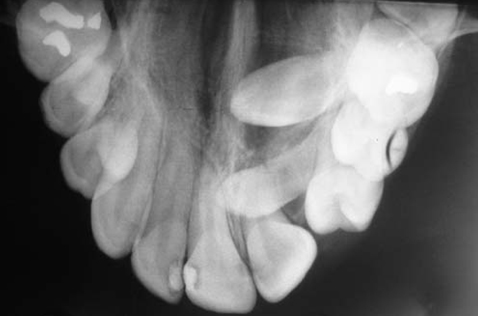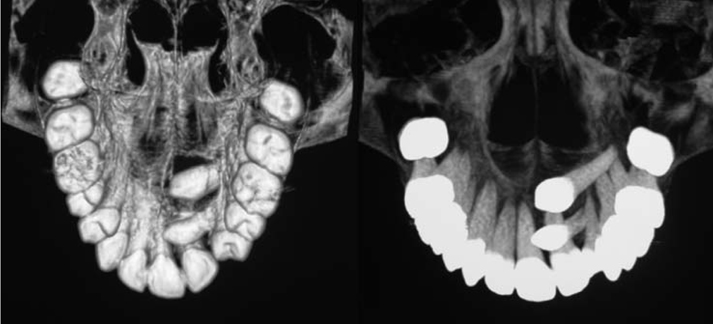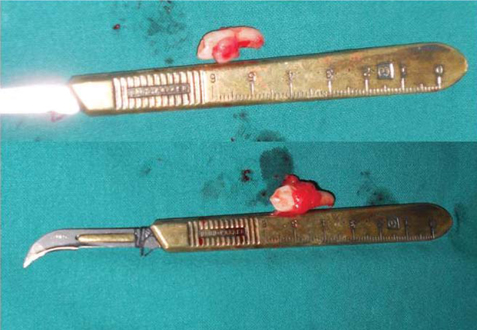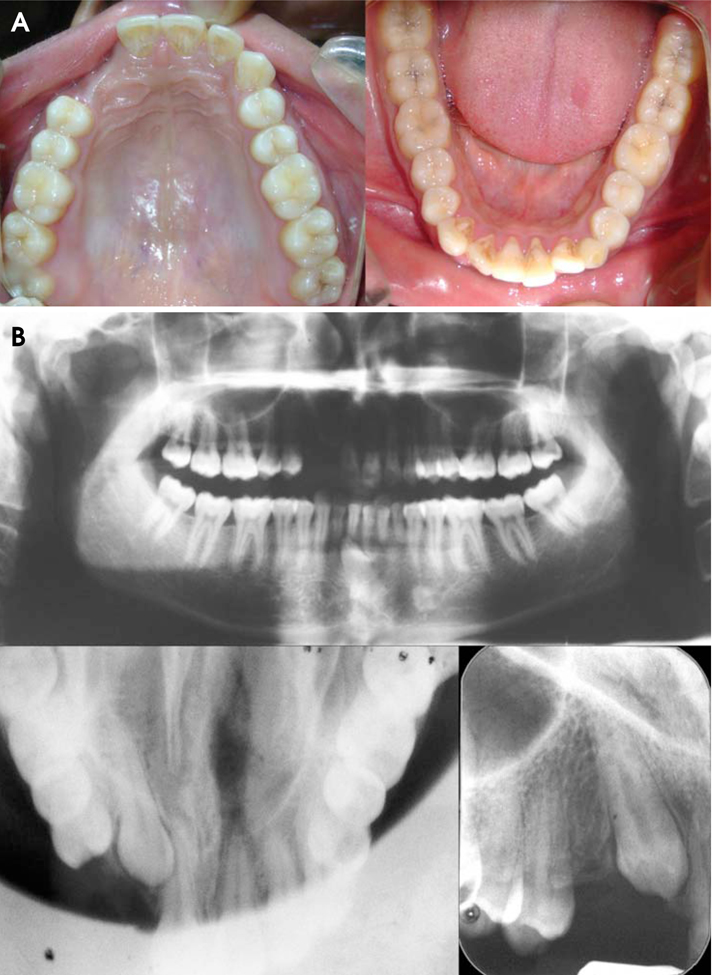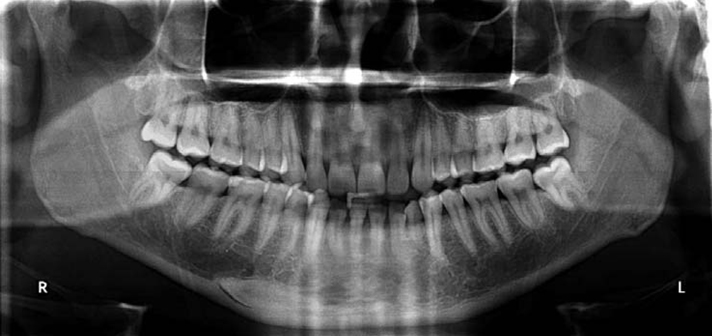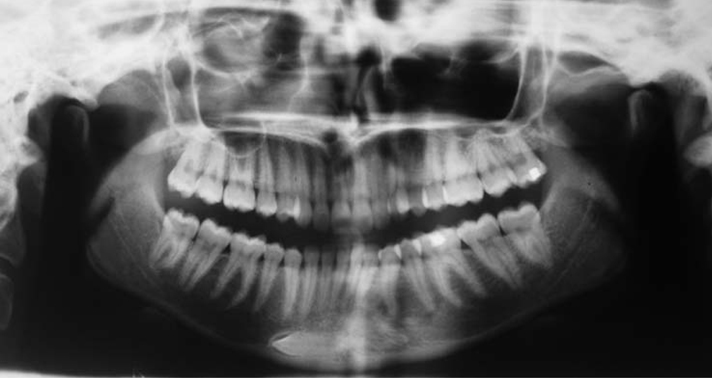Imaging Sci Dent.
2012 Mar;42(1):47-54. 10.5624/isd.2012.42.1.47.
Unusual intraosseous transmigration of impacted tooth
- Affiliations
-
- 1Department of Orthodontics and Dentofacial Orthopedics, Manipal College of Dental Sciences, Manipal, India. drsantoshortho@gmail.com
- 2Department of Oral and Maxillofacial Surgery, Manipal College of Dental Sciences, Manipal, India.
- 3Department of Prosthodontics, Manipal College of Dental Sciences, Manipal, India.
- 4Department of Orthodontics and Dentofacial Orthopedics, Manipal College of Dental Sciences, Manipal, India and Case Western Reserve University, Cleveland, USA.
- KMID: 1974407
- DOI: http://doi.org/10.5624/isd.2012.42.1.47
Abstract
- Transmigration of an impacted tooth through the symphyseal suture is a rare and special developmental anomaly of unknown etiology that is unique to the mandibular canine. Maxillary canine transmigration is even rarer. Transmigrated canines are particularly significant due to the aesthetic and functional importance. A maxillary lateral incisor crossing the mid-palatal suture has never been reported in the literature. The aim of this report is to present the first case of simultaneous transmigration of a lateral incisor and canine in the maxilla. The paper also reports four unusual cases of unilateral canine transmigration in the maxilla and mandible and successful eruption of one of the transmigrated mandibular canines following orthodontic traction. Etiology of transmigration and its clinical considerations are also discussed.
Keyword
Figure
Reference
-
1. Celikoglu M, Kamak H, Oktay H. Investigation of transmigrated and impacted maxillary and mandibular canine teeth in an orthodontic patient population. J Oral Maxillofac Surg. 2010. 68:1001–1006.
Article2. Camilleri S. Double transmigration and hyperdontia. Angle Orthod. 2007. 77:742–744.
Article3. Aydin U, Yilmaz HH. Transmigration of impacted canines. Dentomaxillofac Radiol. 2003. 32:198–200.
Article4. Aydin U, Yilmaz HH, Yildirim D. Incidence of canine impaction and transmigration in a patient population. Dentomaxillofac Radiol. 2004. 33:164–169.
Article5. Shapira Y, Kuftinec MM. Unusual intraosseous transmigration of a palatally impacted canine. Am J Orthod Dentofacial Orthop. 2005. 127:360–363.
Article6. Ryan FS, Batra P, Witherow H, Calvert M. Transmigration of a maxillary canine. A case report. Prim Dent Care. 2005. 12:70–72.
Article7. Aras MH, Büyükkurt MC, Yolcu U, Ertas U, Dayi E. Transmigrant maxillary canines. Oral Surg Oral Med Oral Pathol Oral Radiol Endod. 2008. 105:e48–e52.
Article8. Aktan AM, Kara S, Akgünlü F, Malkoç S. The incidence of canine transmigration and tooth impaction in a Turkish subpopulation. Eur J Orthod. 2010. 32:575–581.
Article9. Joshi MR. Transmigrant mandibular canines: a record of 28 cases and a retrospective review of the literature. Angle Orthod. 2001. 71:12–22.10. Trakyali G, Cildir SK, Sandalli N. Orthodontic treatment of a transmigrated mandibular canine: a case report. Aust Orthod J. 2010. 26:195–200.11. Wertz RA. Treatment of transmigrated mandibular canines. Am J Orthod Dentofacial Orthop. 1994. 106:419–427.
Article12. Tarsitano J, Wooten J, Burditt J. Transmigration of nonerupted mandibular canines: report of cases. J Am Den Assoc. 1971. 82:1395–1397.
Article13. Javid B. Transmigration of impacted mandibular cuspids. Int J Oral Surg. 1985. 14:547–549.
Article14. Auluck A, Nagpal A, Setty S, Pai K, Sunny J. Transmigration of impacted mandibular canines - report of 4 cases. J Can Dent Assoc. 2006. 72:249–252.15. Mupparapu M. Patterns of intra-osseous transmigration and ectopic eruption of mandibular canines: review of literature and report of nine additional cases. Dentomaxillofac Radiol. 2002. 31:355–360.
Article16. Marks SC Jr, Schroeder HE. Tooth eruption: theories and facts. Anat Rec. 1996. 245:374–393.
Article17. Bruszt P. Neurological anomaly associated with extreme malposition of a mandibular canine. Oral Surg Oral Med Oral Pathol. 1958. 11:89–90.
Article18. Sutton PR. Migration and eruption of nonerupted teeth: a suggested mechanism. Aust Dent J. 1969. 14:269–270.
Article19. Pippi R, Kaitsas R. Mandibular canine transmigration: aethiopathogenetic aspects and six new reported cases. Oral Surg. 2008. 1:78–83.
Article20. Auluck A, Mupparapu M. Transmigration of impacted and displaced maxillary canines: orientation of canine to the midpalatine suture. Am J Orthod Dentofacial Orthop. 2006. 129:6–7.
Article21. Vichi M, Franchi L. The transmigration of the permanent lower canine. Minerva Stomatol. 1991. 40:579–589.
- Full Text Links
- Actions
-
Cited
- CITED
-
- Close
- Share
- Similar articles
-
- Treatment of an impacted inverted tooth: A case report
- Orthodontic treatment of molar teeth impacted by local factors
- A comparative Ki-67 expression of odontogenic keratocysts(OKCs) with or without impacted tooth
- Clinical evaluation of efficacy of transcortical anesthesia for the extraction of impacted mandibular third molars: a randomized controlled trial
- Orthodontic Traction of the Permanent Molar Using Skeletal Anchorage: A Case Report

